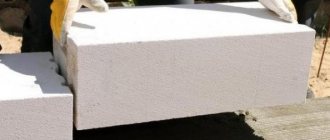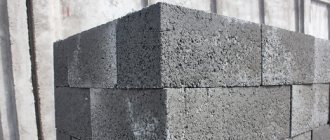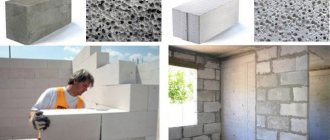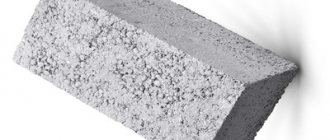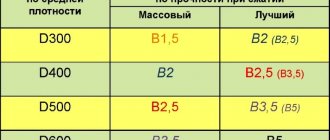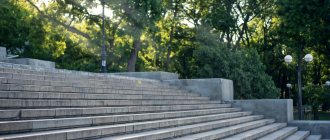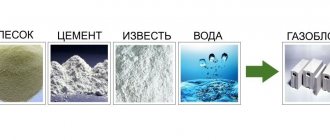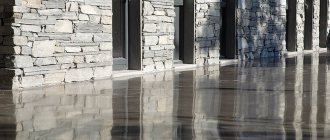Beton-House.com
Website about concrete: construction, characteristics, design. We combine the experience of professionals and private craftsmen in one place
Expanded clay concrete block
Materials that are varieties of concrete have not lost their popularity over the years. This is due to the properties of the products and the excellent performance of buildings built from them.
In this article we will understand what is remarkable about this type of lightweight concrete, expanded clay concrete. And how does it differ from materials with similar characteristics. Properties of expanded clay concrete: let's take a closer look at the characteristics and their indicators.
Pros and cons of houses made of expanded clay concrete
Advantages
- Minimum load on the foundation. The porous structure of the blocks reduces their weight compared to brick. This allows you to save money when arranging load-bearing structures.
- High strength and durability of walls. Expanded clay concrete is allowed for the construction of load-bearing walls, but solid blocks must be used. The material is suitable for basements and multi-storey buildings. The durability of expanded clay concrete is due to the fact that it is able to withstand many freeze/thaw cycles.
- Low cost of building a box house. It is easier to work with expanded clay concrete than with heavy, but smaller bricks, which means that its masonry will cost less.
- Minimal shrinkage. Cracks do not form on the walls made of expanded clay concrete during the operation of the house. But it is important that during the production of blocks all technical processes are followed, including its final drying.
- Low level of thermal conductivity of walls. A house made of expanded clay concrete is initially very warm. Previously, expanded clay, which was part of the blocks, was used to insulate attics and brick walls.
- Eco-friendly home. Expanded clay concrete does not contain any toxic or environmentally harmful components. Such housing is absolutely safe for human health.
- High level of sound insulation. There is no need to apply additional finishing to protect against noise from the street. But if the house is located near a busy highway, then you should also think about installing windows with additional sound insulation.
- The walls are protected from rodents, insect pests and other biological damage. There is no need to regularly treat walls with fungicidal or antiseptic compounds.
- The walls “breathe”. Inside a house made of expanded clay concrete there is never a “thermos effect”, which is a problem for properties made of brick or many other artificial blocks. At the same time, the material is not blown through like shell rock, so heat is well retained indoors in winter.
- The walls are securely held by fastening elements, such as anchors. You cannot screw a self-tapping screw into expanded clay concrete, but a dowel with a plug will fit in easily. Therefore, hanging a shelf on the wall will not be difficult.
Flaws
- High level of water absorption of walls. This drawback only applies to blocks that contain more expanded clay than concrete. Usually they are used only for laying partition walls.
- The material crumbles. This indicates the low quality of the concrete that was used to make the blocks. Therefore, for construction you should purchase only certified products from reliable suppliers.
- Difficulties in fixing fasteners. On the one hand, the high strength of the material is its advantage, but on the other hand, to fix the dowel in the wall, you will first have to make a hole in it using a hammer drill.
- Unaesthetic appearance of blocks. Both the outside and the inside of the walls require finishing. In addition to its attractive appearance, it will also protect expanded clay concrete from moisture.
- High level of water absorption of walls. This drawback only applies to blocks that contain more expanded clay than concrete. Usually they are used only for laying partition walls.
Comparative characteristics with other blocks
If you compare the technical characteristics of KB blocks, aerated concrete and foam concrete, you can see that they are similar in many properties. Thus, approximately the same indicators are observed in terms of frost resistance and thermal conductivity.
The significant superiority of KB is noticeable in lower moisture absorption and higher strength.
| Odds | KB blocks | Foam block | Gas silicate block |
| Strength | 25-110 | 10-60 | 10-40 |
| Density | 500-1700 | 450-800 | 200-800 |
| Water absorption,% | 45 | 90 | 95 |
Composition, regulatory documents and grades of expanded clay concrete
Expanded clay concrete is a porous composite material that is used for block and monolithic construction. In addition to cement and sand, its composition includes expanded clay, which is small light spheres obtained by firing low-melting intumescent clay in a rotating kiln at a temperature of 1100-1200°C. Depending on the size of the fraction, expanded clay grains are 5-40 mm.
Based on strength and density, expanded clay concrete is divided into grades:
- M50 – used for filling interior walls;
- M75 – suitable for load-bearing structures of buildings for any purpose;
- M100 - a budget option for pouring screeds;
- M150 – used for the production of block products;
- M200 – suitable for blocks and lightweight floors;
- M300 - used in the construction of bridges and road slab elements.
- Depending on the density, expanded clay concrete is divided into 3 groups.
| Bespeschany | Porous | Dense |
| It is made without adding sand, so it is large-porous. It is characterized by low cost. Used for pouring walls, floors, and ceilings in low-rise construction. | Used for the production of expanded clay concrete blocks. Depending on the density, there are 3 types: thermal insulation, structural, wall. | It contains a higher percentage of cement, so it is more expensive than other options. Used more often in industrial construction. |
Important!
Expanded clay concrete used for construction must comply with the requirements of GOST 25820-2014. Concrete is lightweight.
Cellular concrete
Aerated concrete block
Features of production.
Both gas and foam concrete are a type of cellular materials, in the thickness of which there are many pores. These concretes are similar in structure, but different technologies are used for their production.
Aerated concrete
made from a mixture of water, quartz sand, Portland cement and caustic soda (caustic soda) by introducing aluminum powder or paste into it, which serves as a gas former.
As a result, a process reminiscent of proofing dough on a sponge occurs, and the mass becomes porous. Moreover, this structure is clearly expressed on the surfaces of the block (foam concrete has closed cells, and the outside is more “smooth”). Aerated concrete is produced only by the autoclave method (under pressure and at high temperatures), so it is impossible to make it outside the factory, which is a certain guarantee of the quality of the material.
In addition, responsible manufacturing companies voluntarily certify their products. Size range of products: 600 × 250 × 100 (200, 250, 350, 450, 500) mm. Price - from 2300 rub./m³.
Foam blocks
Foam concrete is produced from a mixture of water, sand and cement. The foaming agent here is special additives on an organic or harmless synthetic basis. The mass gains hardness in its natural environment, which is why this material is also called non-autoclaved cellular concrete. In serious production, the entire production process, from selecting and measuring raw materials for the mixture to calibrating and cutting products, is under automatic control. Such blocks have characteristics that comply with technical standards, clear dimensions: 200 (250, 300, 400) × 200 × 400 and 200 × 300 × 600 mm - and strictly verified geometry. With all this, there is a danger of ending up with products from semi-handicraft enterprises, whose adherence to technology is highly questionable. How not to make a mistake with your choice and purchase really high-quality material?
The first thing the buyer needs to find out is whether a hygiene certificate and a certificate of conformity are available. How many years has the company been on the market? It is desirable that it has its own laboratory for testing product samples, which issues a quality certificate for each batch of goods. It should indicate the date of production of the blocks, indicate their strength class, density and other characteristics. The next point is checking the geometry and dimensions of the products, for which it is necessary to measure several blocks (permissible deviations from the declared parameters are no more than 2 mm) and compare the results. Take a piece of material (it should be light and not crumble in your hands) and take a closer look at the chip: in “correct” foam concrete, the cells are evenly distributed throughout the mass and have a uniform structure. The price of these products depends mainly on the proportion in which the initial components of the mixture are used. Unscrupulous manufacturers can, for example, save on cement or foaming agent, which leads to a decrease in the strength of the material. In general, a missing amount of any of the ingredients significantly impairs the quality of the product. The average cost of foam blocks is from 2790 rubles/m³.
Unlike expanded clay concrete, masonry made from cellular blocks shrinks. For aerated concrete it is minimal (0.5 mm per meter of wall height), and for foam concrete it ranges from 1 to 3 mm, which can cause cracks in the structure when choosing blocks of insufficient strength or errors in foundation calculations
Properties of materials.
Due to the large number of pores, cellular concrete has a low thermal conductivity coefficient and dampens sound well, so that walls made from it fully meet the requirements for sound insulation of residential premises.
The laying of cellular blocks is carried out using a special glue
. Cellular concrete “breathes”, helping to maintain a normal microclimate in the house, belongs to the highest class of fire resistance (NG) and is immune to biological and chemical influences. In terms of environmental friendliness, they are not inferior to natural materials (only wood is unrivaled) and do not create difficulties when processed with ordinary hand tools. In addition, the blocks are lightweight (maximum 30 kg), so they are easy to carry and stack - no lifting equipment is needed for this, but most importantly, they do not exert serious pressure on the foundation. The exact dimensions of the modules allow the masonry to be laid not on mortar, but on a thin layer of adhesive mixture. The result is seams that are only 2–3 mm thick instead of 10–12 mm. Thus, there are no cold bridges in the wall, and, in fact, it acquires the properties of a monolithic one.
It is worth mentioning that only cellular blocks of the 1st category can be placed on the adhesive composition with a dimensional tolerance of ± 1 mm (mainly products made from autoclaved concrete); with larger deviations, GOST allows installation exclusively on the mortar - to compensate for unevenness due to the thickness of the seam .
A general disadvantage of walls made of cellular concrete is that they do not hold conventional fasteners for hanging furnishings and decor well. The problem is solved with the help of special anchors or plastic dowels, based on the thickness of the masonry and its maximum pullout loads
All of the above applies equally to both types of cellular concrete. But there is an important difference between the materials, which manifests itself in the ratio of their basic characteristics - strength and density. It is this ratio that you should primarily focus on when choosing blocks.
Thus, walls made of aerated concrete will provide the necessary thermal insulation and will bear a greater load with a smaller thickness of the structure than in the case of construction from foam blocks of the same density. In other words, at low density, the heat-insulating properties of foam concrete are better, but the strength for load-bearing walls is insufficient, and they need to be made thicker.
Construction of a wall made of aerated concrete with insulation
Depending on the strength and density, the products are divided into thermal insulation (from B0.5 to B1, 300–500 kg/m³), structural and thermal insulation (from B1 to B5, 500–900 kg/m³) and structural (from B5 to B12.5, 1000 kg/m³ and more). For the construction of load-bearing walls and partitions in houses no higher than three floors, it is recommended to use cellular blocks with a strength of B2.5 and a density of 500–600 kg/m³.
Another difference between gas and foam concrete is the water absorption rates. In the latter it is noticeably lower, but due to the fact that any masonry made of porous blocks is subject to mandatory finishing to protect it from moisture, this circumstance must be taken into account and nothing more. The main condition is not to make the protective and decorative layer an obstacle to the passage of water vapor through the wall. For this purpose, a ventilated gap is provided under the cladding, and the facades are covered with vapor-permeable plasters and paints.
Despite the high thermal insulation performance, walls made of cellular concrete definitely need to be insulated.
This allows them to be brought to the level of heat conservation, which is established by SNiP 02/23/2003 “Thermal protection of buildings”, reduces the cost of heating a house and significantly extends the service life of wall structures. The problem can be solved not only by laying insulation boards, but also by applying special heat-insulating plaster with a layer thickness of 20 mm.
In terms of resistance to heat transfer, a building envelope made of foam or aerated concrete blocks is three times superior to brickwork, and eight times superior to cinder block.
When building from foam and gas blocks, one should take into account their relatively low bending strength (2–7.5 and 2.5–15 MPa, respectively) and, as a consequence, the resulting “hypersensitivity” to foundation movements. So the ease of masonry made from these materials should not deceive the developer: their “lightness” does not mean that professional engineering calculations can be neglected when designing, or, for reasons of economy, the construction of a house can be entrusted to unskilled workers.
Aerated concrete or expanded clay concrete: which is better for the home?
The load-bearing capacity of any material determines its strength. The leader in this parameter is undoubtedly expanded clay concrete. Having a density of D800-D1200, these blocks will have a strength of 50-150 kg/cm2. In comparison, for aerated concrete the parameters are D400-600 and 35-65 kg/cm2, respectively.
When choosing aerated concrete or expanded clay concrete for a house, you need to understand that blocks with expanded clay are allowed to be used for the construction of houses up to 12 floors high. Aerated concrete loses here too - a maximum of 3 floors. Other parameters for comparison are presented in table form.
| Options | Aerated concrete | Expanded clay concrete |
| Thermal insulation characteristics | Can be used in 1 layer of masonry without insulation | It is necessary to insulate |
| Frost resistance (freeze/thaw cycles) | F50-100 | F50 |
| Hygroscopicity (moisture absorption by mass) | 25% | 10% |
| Vapor permeability | 20-23 mg/(m*h*Pa) | 0.3-0.9 mg/(m*h*Pa) |
| Shrinkage | 0.3 mm/m | 0.4 mm/m |
| Resistance to open fire | 7 o'clock | 3 hours |
Compared to foam concrete, expanded clay concrete has lower thermal conductivity. But at the same time, foam concrete has better frost resistance.
Important!
Aerated blocks are cut from a hardened massif, so they have more precise geometric parameters. During production, expanded clay concrete blocks are poured into separate molds, where they remain until completely hardened. According to GOST, for such material deviations in width or length are allowed up to 3 mm, and in height up to 4 mm.
Standard size of expanded clay concrete block
The fact is that there is no separate standard for expanded clay concrete blocks. This type of material is described by a group of standards that regulate lightweight concrete and products made from it. Thus, the dimensions of wall blocks made of lightweight concrete are established by GOST 6133-99.
Standard size of expanded clay concrete block according to GOST 6133
Maximum deviations are also indicated. They are ±3 mm in length, ±4 mm in height, the thickness of the walls between the partitions can be 3 mm thicker (they cannot be thinner).
Popular size of expanded clay concrete block for walls and partitions
Most often, expanded clay concrete blocks measuring 390*190*188 mm are used for laying walls. It turns out to be very convenient, since for central Russia the optimal wall thickness is 400 mm. That is, the masonry is laid “in one block.” Partitions usually require a smaller thickness - 90 mm. The length and height remain the same. That is, the size of the expanded clay concrete block for partitions is 390*90*188 mm. This does not mean that partitions cannot be made from longer or shorter partition slabs. It’s possible, but shorter ones mean more seams, more mortar consumption, and longer ones are heavier and more difficult to work with.
Expanded clay concrete partition block: dimensions according to GOST
If you want to have better sound insulation parameters between rooms, the partitions can also be made from wall blocks. Either the standard width is 190 mm, or the thinner ones are 138 mm. But the costs are higher.
Non-standard dimensions
The standard contains a note that, in agreement with the customer, the size of the expanded clay concrete block can be any. So you can find products in any format.
The size of an expanded clay concrete block of this format cannot be considered standard
In addition, there are also technical conditions (TS), which are developed and registered by the enterprises themselves. If you are going to purchase a large batch and the labeling is not GOST 6133-99, but TU, it is better to familiarize yourself with this document so that there are no surprises.
Monolith or expanded clay concrete?
Construction using expanded clay concrete will cost less than pouring monolithic concrete walls. It will not take so much time for the load-bearing structures to shrink and harden. If you assemble walls from expanded clay concrete blocks, you can begin finishing literally a few days after completion of the work. In the case of concrete, you will have to wait up to several months.
| Index | Tree | Slotted brick | Porous block | Expanded clay concrete | Foam concrete | Aerated concrete |
| Density, kg/m3 | 500 | 1400-1700 | 400-1000 | 850-1800 | 600-1000 | 300-600 |
| Thermal conductivity, W/m Co | 0,14 | 0,5 | 0,18-0,28 | 0,4-0,8 | 0,14-0,22 | 0,08-0,14 |
| Strength, kgf/cm2 | 100-200 | 100-150 | 35-75 | 15-25 | 25-50 | |
| Water absorption, % mass | 12-18 | 10-16 | 10-16 | 25 | ||
| Frost resistance, cycles | 100 | 100 | from 50 | from 35 | from 50 | |
| Recommended wall thickness, m (for the middle zone) | from 1.2 | from 0.6 | from 1 | from 0.6 | from 0.4 |
Concrete walls are strong, but at the same time they have a minimum density. This increases thermal conductivity, so monolithic walls require mandatory insulation. Additional benefits of concrete include its durability. If all technologies are followed, monolithic walls can withstand up to 150 freezing/defrosting cycles. For expanded clay concrete this parameter is only 50.
Standard solutions for the middle zone
When building a house, it is best to order a project. Here everything will be taken into account for you, all components and materials will be prescribed, including the size of the expanded clay concrete block, its parameters and quantity. All that remains is to purchase everything according to the list. But few people do this. A project is an expense, and money is already scarce. Therefore, they try to roughly “estimate” without making calculations. The position is also understandable, but it does not always lead to savings, because “standard solutions” are made with a margin of safety, and this is an overconsumption of material. But, in general, there are proven options for the composition of the pie of external walls made of expanded clay blocks for Russia.
- Only blocks without insulation. Wall thickness - 600 mm. The size of the expanded clay concrete block for the outer wall is 590*290*200 mm, the blocks are hollow, structural and thermal insulating. Place the blocks with the voids facing up and fill them with heat-insulating material. The most convenient way is to use polystyrene foam chips. The interior is finished with plaster or plasterboard, the exterior is finished with plaster.
Examples of laying expanded clay blocks - Expanded clay block 400 mm + insulation. For an external wall, it is more convenient to use an expanded clay concrete block measuring 390*190*200 mm. When laying in a bandage we get 40 mm thickness. The insulation layer must have a thermal conductivity coefficient of 0.05 W/m °C. For mineral wool and expanded polystyrene it is about 50 mm.
- Multi-slot block made of expanded clay concrete 500 mm thick without insulation. The dimensions of the expanded clay concrete block must be selected, since they often come in non-standard sizes. Can be found in 500mm length and 250mm width. It will be convenient to place it in the usual way with dressing. Or you can use other formats, but you will need to develop a masonry scheme.
Another popular solution is with brick cladding. - Expanded clay wall 290 mm thick + insulation. For this option, you can use a large-format block. According to GOST, its size is 288*288*138 mm, but it weighs a lot and is more difficult to work with. You can use a narrower one - 138 mm wide, which will almost give the required thickness. About 100 mm of insulation is needed, interior finishing is plaster or drywall.
When choosing expanded clay blocks, we look at two indicators: compressive strength class - for load-bearing walls it should be at least B3.0 (with a margin). The second indicator is the thermal conductivity coefficient. The lower it is, the better.
Calculation of the number of expanded clay concrete blocks for building a house
The calculation can be made based on the area of the house or volume. The algorithm is quite simple, for example, let's take a one-story house with walls 10 by 20 meters, the ceiling height of which is 3″ meters.
We use the following calculation formulas:
- We calculate the total area of the walls. In this case it will be (10+10+20+20)*3 = 180 m2.
- For 1 m2 of wall you will need 12.5 expanded clay concrete blocks. This can be calculated if you know the dimensions of the building element 200x200x400 mm. We use the formula: 1/0.4x0.2 = "12.5.
- It remains to multiply the area of the walls by the number of blocks: 180x12.5 = "2250 pieces.
- If the calculation is performed not by area, but by volume, then to obtain the number of required blocks, the volume of masonry and the size of one unit of building material are used.
Important!
When performing calculations, the dimensions of window and door openings are not taken into account. This is necessary to take into account possible losses of building material during the work.
Construction stages:
- Design and marking of the site.
- Construction of the foundation.
- Laying load-bearing walls.
- Construction of partition walls.
- Installation of roofing system.
- Insulation.
- External and internal finishing.
Briefly about the main thing
Aerated concrete blocks and expanded clay blocks belong to the group of cellular building materials with good acoustic, thermal insulation properties and strength properties; they do not burn, practically do not shrink and are considered environmentally friendly.
Both options are suitable for the construction of load-bearing walls and partitions. But in terms of resistance to mechanical loads, aerated concrete is noticeably inferior. Expanded clay concrete can be prepared on the work site and poured into the floor, to form monolithic floors and vertical structures.
Water absorption is also considered similar. The indicators are different, but materials must be protected from direct contact with water. Therefore, they are not applicable for the construction of foundations and basements.
Foundation for a house made of expanded clay concrete
The reliability and durability of an expanded clay concrete house directly depends on the quality of its foundation. If it weakens or “floats” over time, this will lead to the formation of cracks on the walls, which will only expand over time. Eliminating them will require a significant investment of time and money.
Since expanded clay concrete blocks are relatively light in weight, a massive foundation for such a house is not required. For sandy and sandy loam soils, it is recommended to use a columnar base with a monolithic grillage. A shallow strip foundation is also ideal. For two-story houses, a more serious foundation made of monolithic concrete with additional reinforcement is recommended. For unstable soils, screw piles are used.
Another option for a foundation is a slab foundation. It involves laying ready-made reinforced concrete slabs at the site, which were pre-fabricated at the factory. Such a foundation is used quite rarely, since special transport is required to deliver the slabs to the site. And to unload them, it is necessary to use heavy construction equipment. The only advantage of a slab foundation is that there is no need to wait for the concrete to harden and shrink, as is the case when pouring the foundation on site.
The shallow strip foundation of a house made of expanded clay concrete is erected in several stages:
- Marking the contour of the base according to the project plan. When choosing a location, the location of other objects on the site is taken into account.
- Construction of a pit. Usually its width is about 50 cm. But it all depends on the type of formwork, which can be removable or permanent. Its width must be summed up.
- Roofing felt or other waterproofing material is placed at the bottom of the trench, which can prevent the destruction of the foundation under the influence of moisture.
- The base of the trench is filled with a mixture of crushed stone and sand, and then carefully compacted.
- The frame is assembled from reinforcing bars. To connect them, a binding wire is used. Welding is not suitable because it does not provide the required degree of spatial expansion during the concrete hardening process.
- Concrete grade M400 is used to fill the foundation. It can be prepared on site or ordered delivered to the site by concrete truck.
- After filling the formwork with concrete, all air bubbles must be removed from it. Vibrating equipment is used to compact the composition.
- After leveling the surface, the concrete is left until completely hardened. This process, depending on weather conditions, takes up to 1 month.
- If removable formwork was used, then at the last stage it is dismantled. After this, you can begin waterproofing the foundation.
Foam concrete as an effective heat insulator
It must be said that the number of Russian construction companies that prefer expanded polystyrene foam (PPS) to thermal insulating foam concrete is quite large, however, since everything is learned by comparison, we will try to determine what advantages of foam concrete are not yet fully appreciated by some developers.
First of all, PPS, used for insulation of external walls, retains its thermophysical characteristics, subject to compatibility with other building materials. In addition, during operation, a number of factors appear that can accelerate its destruction. Western experts believe that PPS will last no longer than three decades without losing its basic properties. With the adoption of more stringent standards for the thermal protection of enclosing structures, it became necessary to increase the thickness of the EPS layer in the case where the walls are built using flexible metal connections, from 4–9 to 15–30 cm. The result of this was shrinkage, deformation and deterioration in the thermal insulation properties of the material. Do not forget how destructive chemical reagents affect polystyrene foam, and also that when ignited (PPS is classified as flammability classes G4 and G3, with fire retardant additives - G1), it releases toxic substances. Now let’s compare the properties of expanded polystyrene and thermal insulating foam concrete.
Under normal operating conditions, foam concrete is one of the most durable materials. In terms of environmental friendliness, it is second only to wood, but unlike it (not to mention polystyrene foam), it does not change its properties during prolonged use and does not burn (NG class). Moreover, foam concrete prevents the spread of fire and can protect reinforcement from overheating for a long time. It is resistant to chemicals and is not susceptible to biological damage. Regardless of unfavorable environmental factors, the material accumulates heat, thereby significantly reducing home heating costs.
Laying the walls of a house made of expanded clay concrete
Expanded clay concrete is placed on a special glue or cement mortar. The second option is more often used for blocks with irregular geometry, since it allows you to eliminate small irregularities. The adhesive is suitable for expanded clay concrete without flaws. Its use allows you to reduce the width of the seams to 3-5 mm. This significantly reduces heat loss from the wall and avoids the formation of “cold bridges”.
Laying is carried out in several stages:
- The foundation is covered with a layer of waterproofing. This prevents the expanded clay concrete from absorbing moisture from the soil.
- The corner blocks are laid first. A thread is pulled level between them, which helps control the evenness of the masonry.
- When using cement mortar, it is applied to the base of the block. There should also be additional adhesive on the side.
- If an uneven level is observed during the laying process, a rubber mallet is used to eliminate it.
- The second row is laid so that the seams of the previous one are located approximately halfway across the block.
- The first and every 4th row of masonry is reinforced with metal mesh or reinforcement bars. Reinforcement is necessarily used in the locations of window and door openings. The optimal distance is up to 90 cm.
- A separate reinforcing belt is made around the perimeter to distribute the load from the roof rafters. To make it, you can use blocks that are hollow inside (U-shaped). After they are laid, reinforcement is placed inside and filled with concrete mortar.
- For partition walls, smaller or hollow blocks, which are cheaper, are suitable.
Important!
In the reinforcing belt it is necessary to provide fastenings for the Mauerlat. Studs that are installed in a hollow block before pouring the foundation are ideal.
GOST
According to the GOST standard, the composition of expanded clay concrete should include only high-quality raw materials:
- The stones contain white and colored Portland cement, which meets the standards.
- The composition of lightweight concrete should include: crushed stone, gravel and sand, ash, slag mixtures and other components that are defined by the standard.
- To fill the solution, you can use crushed stone and gravel made from rocks.
KB according to GOST 25820-2000 must be made from aggregates that have fractions of 1 cm (in the case of a hollow block) and 2 cm (for a solid block). To obtain color, you can use pigments of inorganic origin.
The following video will tell you whether the use of expanded clay concrete can be dangerous:
Arrangement of the roofing system
Stages of construction of a pitched roof:
- The Mauerlat is attached to the last row of masonry walls, which was additionally reinforced. It consists of wooden boards connecting the rafters to the wall.
- The rafter system, with small dimensions, is assembled on the ground and only then completely lifted up. First, the outer rafter legs are installed, and then a control thread is pulled between them. It serves as a guide for installing other rafters.
- The waterproofing material is laid out. It is fixed to the rafters using a counter-lattice. The sheathing is placed on top and the roofing material is laid.
For houses made of expanded clay concrete, a pitched roof is most often chosen. Its frame is made of wood. For the Mauerlat, bars measuring 150 by 150 mm are taken. And for the rafter system, boards 75 mm wide are suitable. Slate, metal or soft tiles are suitable as roofing materials. The best option is a soft roof. It has a long service life, while the material is affordable and comes in a variety of colors.
Wall insulation and ventilation system
To insulate the walls of a monolithic house made of expanded clay concrete, mineral wool is used. It also “breathes”, so it removes moisture well and prevents the formation of condensation. Also, depending on the material chosen for finishing, glass wool, polystyrene foam or polystyrene foam are suitable.
Technology of wall insulation with mineral wool:
- The surface is cleaned of dirt and unevenness is eliminated. Guides are installed if a ventilated façade is planned.
- Installation of sheathing or base profile. Bars measuring 50 by 50 mm are used. The sheathing pitch is selected depending on the width of the mineral wool slabs, since if the sizes do not match, they will have to be further trimmed.
- The insulation boards are fixed with glue or with disc-shaped dowels. The glue is applied to the slab itself and leveled with a spatula. When using fasteners, you will need 5-7 pieces for each square meter of insulation.
- A vapor barrier membrane is installed. It is mounted on top of the insulation. The material is fixed with a stapler. At the joints it is necessary to provide an overlap of 15 cm and glue these places on top with construction tape.
- The sheathing is mounted on the guides and the cladding is fixed on top of it.
It is imperative to provide an internal ventilation system that will help remove excess moisture from the premises. It can be natural or forced, requiring the installation of electric fans. This is critical for the bathroom, bathroom and kitchen.
Interior and exterior decoration
After completing the construction of a house made of expanded clay concrete, they begin to decorate it. The walls must be plastered, and this applies to both the internal surface and the facade. Even if you plan to cover the house with siding, rough grouting is still required.
The following types of compounds are suitable for plastering walls:
- A mixture of sand and cement. The most budget-friendly finishing option. Proportions 1:4.
- Cement mixture with additional fillers. Sold in the form of dry formulations, packaged in bags. Diluted according to the manufacturer's instructions on the packaging.
- Compositions with hydrophobic characteristics. Extremely necessary for house elements located close to the ground. We are talking about ground floors and basements.
- Gypsum-based mixtures. Used for interior finishing work. Suitable for any type of premises, including residential.
- In addition to plaster, decorative bricks, tiles, artificial stone, clinker, and siding are perfect for exterior cladding of a house.
Important!
Expanded clay concrete walls should not remain unfinished for a long time. This can allow moisture to penetrate into the material, which will shorten its life and impair performance.
